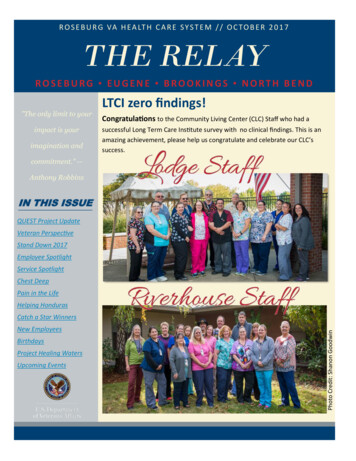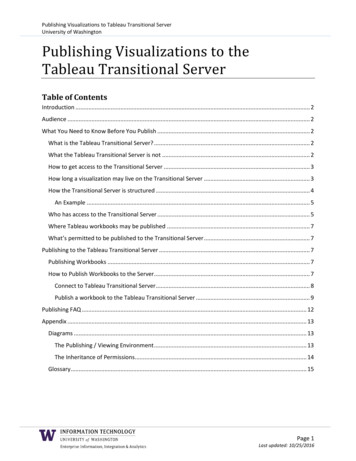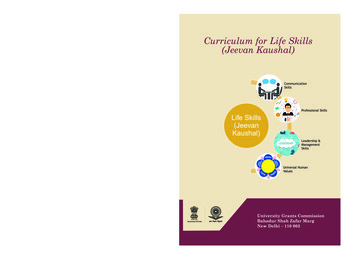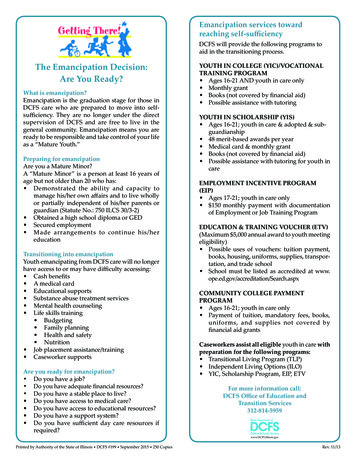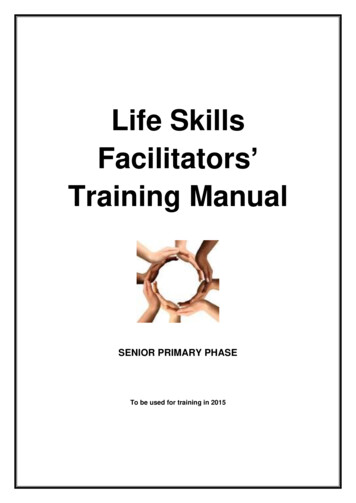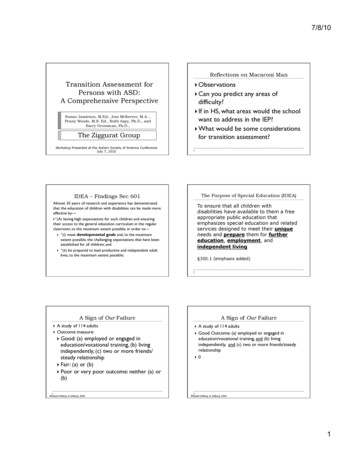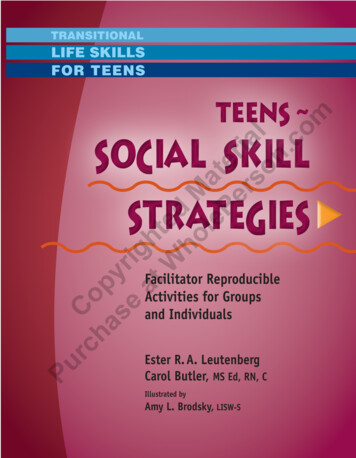
Transcription
IntroductionTRANSITIONALLIFE SKILLSFOR TEENSteens strategiesFacilitator ReproducibleActivities for Groupsand IndividualsFacilitator ReproducibleActivities for GroupsEster R.A. Leutenbergand IndividualsCarol Butler, MS Ed, RN, CtCch oas pye rigat hW tedho Mle atPe errs ialon.cot msocial teensskill socialskillstrategiesPurIllustrated byAmy L. Brodsky, LISW-SEster R. A. LeutenbergCarol Butler, MS Ed, RN, CIllustrated byAmyL. Brodsky, LISW-SDuluth, Minnesota 2014 WHOLE PERSON ASSOCIATES, 101 WEST 2ND ST., SUITE 203, DULUTH MN 55802 800-247-6789i
Cch oas pye rigat hW tedho Mle atPe errs ialon.comTEENS – Social Skill StrategiesWhole Person101 West 2nd St., Suite 203Duluth, MN son.comTeens – Social Skill StrategiesFacilitator Reproducible Activities for Groups and IndividualsCopyright 2014 by Ester R.A. Leutenberg and Carol Butler.All rights reserved. Except for short excerpts for reviewpurposes and materials in the activities and handouts sections,no part of this book may be reproduced or transmitted inany form by any means, electronic or mechanical withoutpermission in writing from the publisher. Activities and handoutsare meant to be photocopied.All efforts have been made to ensure accuracy of theinformation contained in this book as of the date published. Theauthor(s) and the publisher expressly disclaim responsibility forany adverse effects arising from the use or application of theinformation contained herein.Printed in the United States of America10 9 8 7 6 5 4 3 2 1PurEditorial Director: Carlene SippolaArt Director: Joy Morgan DeyiiLibrary of Congress Control Number: 2013954258ISBN: 978-157025-306-5 2014 WHOLE PERSON ASSOCIATES, 101 WEST 2ND ST., SUITE 203, DULUTH MN 55802 800-247-6789
IntroductionPurpose of the BookAction and reflection promote learning.In this workbook, TEENS – Social Skill Strategies, teens learn by doing, from each other, andthrough thought and feedback.Cch oas pye rigat hW tedho Mle atPe errs ialon.comReal life comes to the classroom, group room or individual space as teens practice new skillsor begin to change negative behaviors. Awareness of societal expectations, empathy, ethicsand altruism are not taught but are lived, through simulated and actual situations.Social skills constitute more than a time-honored list of modern manners; they are ways tothrive in today’s world. Whether texting or talking, sitting at the table or involved in a crisissituation, operating with family or friends, in school or in love, communication, courtesy andcompassion triumph.Verbal and non-verbal communication, social graces, the desire to fit in, diversity,inclusion, finding and being a friend, family relationships, forgiveness, first love, breakups,humanitarianism and other topics are featured. Social issues, including abuse prevention andother topics are addressed.Experiential education occurs as teens practice ways to achieve these goals. Become a leader Be a team player Portray and interpret body language Launch and join a conversation Use, not abuse, technological communication Elicit and express opinions Enact and analyze social behavior Read and write poetry, songs, lyrics, letters and riddles, expressing feelings related torelationships Develop passion for and ways to promote a social cause Start or participate in a service clubActive learning occurs as teens consider social life and social consciousness throughinteractive games, introspective drawing and writing, mock videos, role plays, paneldiscussions, press conferences, through drama, music, pantomimes and other activities.PurTeens will practice ways to build people up and break down barriers.Teens will internalize Maya Angelou’s message:I’ve learned that people will forget what you said,people will forget what you did,but people will never forget how you made them feel. 2014 WHOLE PERSON ASSOCIATES, 101 WEST 2ND ST., SUITE 203, DULUTH MN 55802 800-247-6789iii
TEENS – Social Skill StrategiesFormat of the BookAn Introduction for Teen Participants motivates teens for the activities (Page vi).A Cover Page for each chapter provides a quotation and description of the sessions. This pagemay be distributed as an introduction to a workshop or series of sessions.Cch oas pye rigat hW tedho Mle atPe errs ialon.comSeven Chapters, four to ten sessions per chapter, (total of forty-seven) encompass the following:1. CommunicationBody language, personal space, behavioral cues, active listening, conversations, firstimpressions, communication starters and stoppers, assertiveness and negotiation skills.2. ExpectationsTechnology, social networking, mealtime, introductions, first dates, events, travel,condolences, diplomacy, job interviews, work relationships and sportsmanship.3. Fitting InParent/caregiver issues, excessive people pleasing, acceptance of self and others, respectfuldisagreement, shyness, positive personality traits, newcomers, diversity and multiculturalcontributions to society.4. FriendshipPositive peer support, non-aggression, frenemies, influence of words and actions, friendshiplyrics, envy and jealousy, and helping a person in crisis.5. FamilyTraditional and non-traditional family styles, changes at home, sibling rivalry, respect forauthority without fear or rebellion, and forgiveness.6. Teen LoveHealthy and unhealthy relationships, parent/caregiver concerns, first love, expression throughart and poetry, dating dilemmas, breakups and power principles.7. CaringEmpathy, social causes, creative fundraisers, ways to help at home, school, community, etc.,advocacy in action, leadership as a passion to serve versus self-serving power.Each chapter may function as a workshop. Provide one session per day or week.Promote themes through posters and flyers. Emphasize the interactive andcollaborative nature of the sessions.Each of the forty-seven sessions may stand alone. Pick and choose per your population.Most sessions are adaptable to interactive or individual activities. Most require at leastfifty minutes and if necessary can be continued the next session or for homework.In Each SessionPurReproducible handout(s) for participants (games, charades, questions, etc.) Read beforesession, cut on the broken lines if directed, white out or add text specific to your teens if necessary,and photocopy.A For the Facilitator page on the back of each teen handout provides the following:I.II.III.IV.Purpose: Goals for teens.General Comments: Brief background information.Possible Activities: Ideas to introduce and present topics. Answer keys or responses to elicit.Enrichment Activities: Additional learning opportunities. Ways to close session or follow up.Sensitive subjects are addressed. Facilitator discretion is advised. Teens need to be remindedthat the supreme social skill is to seek help for oneself or a peer in trouble. Facilitators need torefer teens in crisis for a psychiatric evaluation or to emergency services.iv 2014 WHOLE PERSON ASSOCIATES, 101 WEST 2ND ST., SUITE 203, DULUTH MN 55802 800-247-6789
IntroductionSuggestions for FacilitatingCapitalize on the likelihood that peers are of primary importance to teens.Consider the classroom, group room and/or individual space as a learning lab where teensexperiment with behaviors.Expect movement, discussion, laughter and learning from each other.Cch oas pye rigat hW tedho Mle atPe errs ialon.comTeens – Social Skill Strategies sessions simulate life and provide practice for situations that maybe unfamiliar and uncomfortable. Teens who are shy in real life may be reluctant to role play; teenswho tend toward prejudice may question the value of diversity. The activities are arranged tomotivate change.As a facilitator, your skills will help teens gently move outside their comfort zones.Emphasize that teens may volunteer to participate (or not).Encourage teens to gradually test the waters.(Example: write, draw, share, be a team member and/or eventually become a leader.)Suggest that the higher the level of participation, the greater the benefits.Promote the value of taking risks in session, risks that they wouldn’t take in real life.(Example: Start or join an ongoing conversation during a role play.)Persuade teens to Just do it – but be mindful of your responsibility to others.(Example: let lyrics flow without worrying whether they’re wonderful).Location matters. Expect team members to sit together, arrange chairs in clusters asneeded, for some activities a circle is a friendlier forum than rows; for mock videos or roleplays, set up a stage area and audience seating.For activities that involve social causes, fundraising, leadership, etc., try to promote actualcharitable connections and actions; maybe teens can start a service club if feasible inyour facility.Decide the level of interaction or introspection your teens need and can handle; althoughmost sessions promote peer contact, many activities can be done as individual worksheets.Make the setting safe; ask teens to brainstorm their own ground rules.PurPossibilities: Use name codes (example – for a friend who likes to boss, use LTB - Likes To Boss). Respect people who are reluctant to share. Keep private what people say in class or group. "What's said in this room, stays in this room." Game contestants may ask team members for help as needed. There are few right or wrong answers; on paper or in games, state what is true for you. Open your mind to consider other views, cultures, lifestyles, etc. No put-downs when ideas differ. No mocking if someone’s behaviors seem awkward. Encourage peers to join in activities (as you will learn to include people in real life). Listen actively without interrupting the speaker. If you or a peer feel like harming self or others, tell a trusted adult.Remind teens that the group is a segment of society – skills acquired here transfer to the outside.Our gratitude to the following for their input Annette Damien, MS, PPS and Hanna Lavoie, teenagerAnd to these professionals who make us look good!Art Director – Joy DeyEditor and Lifelong Teacher – Eileen RegenEditorial Director – Carlene SippolaIllustrator – Amy L. BrodskyProofreader – Jay Leutenberg 2014 WHOLE PERSON ASSOCIATES, 101 WEST 2ND ST., SUITE 203, DULUTH MN 55802 800-247-6789v
TEENS – Social Skill StrategiesIntroduction for Teen ParticipantsSocial networking, friends, family, dating and love – what could be more important?How do you deal with your own and others' sensitive situations?How do you handle your own and others' differences?On a wider scale, what do you care about?Cch oas pye rigat hW tedho Mle atPe errs ialon.comIn Teens – Social Skill Strategies you and your peers are partners in learning.You will expand your social comfort zone as you work on many skills:1)2)3)4)5)6)7)8)9)10)11)Mix, mingle, observe and give feedback to each other.Pick up on and portray body language cues.Practice ways to make a good first impression.Become a better conversationalist (on dates, with friends and your own family, with yourfriends' or a partner’s family, new people, co-workers, teachers, etc.).Assert your opinions and settle conflicts.Figure out fitting in – without bending over backwards, with positive personality traits,overcoming shyness, and by welcoming new and different people and ideas.Find friends not frenemies. Operate without envy and jealousy.Manage family issues and handle authority figures people at home and elsewhere.Forgive others and yourself, and learn to apologize.Express feelings about romantic love; understand power in relationships and healfrom breakups.Develop leadership skills and possibly create a club or organization.Social skill strategy activities are fun! Team ActivitiesCharades and picture gamesGame showsTalk showsTic-Tac-ToeBingoRole plays Mock videosPantomime and freeze framesMatch gamesPanels and press conferencesPoetry, songs and lyricsRiddlesArtPurAdditionally, you will have other opportunities to think for yourself, share if you wish, and interact.Major Social SkillI’ve learned that people will forget what you said,people will forget what you did,but people will never forget how you made them feel.– Maya Angelouvi 2014 WHOLE PERSON ASSOCIATES, 101 WEST 2ND ST., SUITE 203, DULUTH MN 55802 800-247-6789
IntroductionTeens – Social Skill StrategiesTABLE OF CONTENTSCch oas pye rigat hW tedho Mle atPe errs ialon.com1. communication . . . . . . . . . . . . . . . . . . . . . . . . . . . . . . . . . . . . . . . . . 9 Body Language “Says” It All. . . . . . . . . . . . . . . . . . . . . . . . . . . . . . . 11 Congruent Conversation . . . . . . . . . . . . . . . . . . . . . . . . . . . . . . . . . 13 Space Invaders . . . . . . . . . . . . . . . . . . . . . . . . . . . . . . . . . . . . . . . . 15 Communication Cues . . . . . . . . . . . . . . . . . . . . . . . . . . . . . . . . . . . 17 Conversations . . . . . . . . . . . . . . . . . . . . . . . . . . . . . . . . . . . . . 19–22 First Impressions . . . . . . . . . . . . . . . . . . . . . . . . . . . . . . . . . . . . . . . 23 Starters . . . . . . . . . . . . . . . . . . . . . . . . . . . . . . . . . . . . . . . . . . . . . 25 Stoppers . . . . . . . . . . . . . . . . . . . . . . . . . . . . . . . . . . . . . . . . . . . . . 27 Pushover to Assertor. . . . . . . . . . . . . . . . . . . . . . . . . . . . . . . . . . . . 29 Negotiation Know-How . . . . . . . . . . . . . . . . . . . . . . . . . . . . . . . . . . 312. expectations . . . . . . . . . . . . . . . . . . . . . . . . . . . . . . . . . . . . . . . . . 33 Tic-Tac-Tech. . . . . . . . . . . . . . . . . . . . . . . . . . . . . . . . . . . . . . . . 35–38 Munch Match . . . . . . . . . . . . . . . . . . . . . . . . . . . . . . . . . . . . . . . . . 39 Edit Your Intros. . . . . . . . . . . . . . . . . . . . . . . . . . . . . . . . . . . . . . . . 41 Social Savant . . . . . . . . . . . . . . . . . . . . . . . . . . . . . . . . . . . . . . 43–46 Consider Consideration . . . . . . . . . . . . . . . . . . . . . . . . . . . . . . . . . 47 Win at Work. . . . . . . . . . . . . . . . . . . . . . . . . . . . . . . . . . . . . . . . . . . 49 Sportsmanship Pyramid . . . . . . . . . . . . . . . . . . . . . . . . . . . . . . . . . 513. fitting in . . . . . . . . . . . . . . . . . . . . . . . . . . . . . . . . . . . . . . . . . . . . . . 53 Parent/Caregiver Puzzle . . . . . . . . . . . . . . . . . . . . . . . . . . . . . . . . . 55 Dr. Fell’s Press Conference. . . . . . . . . . . . . . . . . . . . . . . . . . . . . . . 57Pur New on the Block. . . . . . . . . . . . . . . . . . . . . . . . . . . . . . . . . . . . . . . 59 Personality by the Numbers . . . . . . . . . . . . . . . . . . . . . . . . . . . 61–64 End Exclusion and Embrace Inclusion Acrostic . . . . . . . . . . . . . . . 65 Pieces of Shy . . . . . . . . . . . . . . . . . . . . . . . . . . . . . . . . . . . . . . . . . 67 Corner Shyness . . . . . . . . . . . . . . . . . . . . . . . . . . . . . . . . . . . . . . . 69 The World’s Mosaic. . . . . . . . . . . . . . . . . . . . . . . . . . . . . . . . . . . . . 71 2014 WHOLE PERSON ASSOCIATES, 101 WEST 2ND ST., SUITE 203, DULUTH MN 55802 800-247-6789vii
TEENS – Social Skill Strategies. . . . . . . . . . . . . . . . . . . . . . . . . . . . . . . . . . . . . . . . . . . . 73Cch oas pye rigat hW tedho Mle atPe errs ialon.com4. friendship “I’ve Got Your Back” Charades . . . . . . . . . . . . . . . . . . . . . . . . . . . . 75 A Frenemy. . . . . . . . . . . . . . . . . . . . . . . . . . . . . . . . . . . . . . . . . 77–80 Found Again . . . . . . . . . . . . . . . . . . . . . . . . . . . . . . . . . . . . . . . . . . 81 Song Snippets. . . . . . . . . . . . . . . . . . . . . . . . . . . . . . . . . . . . . . . . . 83 Color Me Jealous or Not . . . . . . . . . . . . . . . . . . . . . . . . . . . . . . . 85 Lifesavers . . . . . . . . . . . . . . . . . . . . . . . . . . . . . . . . . . . . . . . . . . . . 875. family . . . . . . . . . . . . . . . . . . . . . . . . . . . . . . . . . . . . . . . . . . . . . . . . 89 Fam-Mobile . . . . . . . . . . . . . . . . . . . . . . . . . . . . . . . . . . . . . . . . . . . 91 Sib-Rival Survival. . . . . . . . . . . . . . . . . . . . . . . . . . . . . . . . . . . . 93–96 Power Figures. . . . . . . . . . . . . . . . . . . . . . . . . . . . . . . . . . . . . . . . . 97 Riddles. . . . . . . . . . . . . . . . . . . . . . . . . . . . . . . . . . . . . . . . . . . 99–1026. teen love . . . . . . . . . . . . . . . . . . . . . . . . . . . . . . . . . . . . . . . . . . . . 103 First Date . . . . . . . . . . . . . . . . . . . . . . . . . . . . . . . . . . . . . . . . . . . 105 Parent/Caregiver Concerns . . . . . . . . . . . . . . . . . . . . . . . . . . . . . 107 Love-U Bingo . . . . . . . . . . . . . . . . . . . . . . . . . . . . . . . . . . . . .109–112 Pen Your Passion . . . . . . . . . . . . . . . . . . . . . . . . . . . . . . . . . . . . . 113 Dating Dilemmas . . . . . . . . . . . . . . . . . . . . . . . . . . . . . . . . . . 115–118 Freeze. . . . . . . . . . . . . . . . . . . . . . . . . . . . . . . . . . . . . . . . . . . . . . 119 From Ashes . . . . . . . . . . . . . . . . . . . . . . . . . . . . . . . . . . . . . . . 1217. caring . . . . . . . . . . . . . . . . . . . . . . . . . . . . . . . . . . . . . . . . . . . . . . . 123 Diary of A Mensch . . . . . . . . . . . . . . . . . . . . . . . . . . . . . . . . . . . . 125.Pur Swapportunity . . . . . . . . . . . . . . . . . . . . . . . . . . . . . . . . . . . . . . . 127. Care Contract . . . . . . . . . . . . . . . . . . . . . . . . . . . . . . . . . . . . . . . . 129 What’s My Cause? . . . . . . . . . . . . . . . . . . . . . . . . . . . . . . . . 131–134 Leadership: Passion or Power? . . . . . . . . . . . . . . . . . . . . . . . . . . 135viii 2014 WHOLE PERSON ASSOCIATES, 101 WEST 2ND ST., SUITE 203, DULUTH MN 55802 800-247-6789
tcommunication 1CommunicationYou never know when a moment and a few sincere words can have an impact on a life.Body Language “Says” It All. . . . . . . . . . . . . . . . . . . . . . . . . . . . . . page 11t Zig ZiglarCongruent Conversation . . . . . . . . . . . . . . . . . . . . . . . . . . . . . . . . . . . . . . . . . page 13tCch oas pye rigat hW tedho Mle atPe errs ialon.comTeens portray and decipher non-verbal messages in a charades-type game.Teens enhance sensitivity to others’ emotions and learn to monitor the cues they convey.SPACE INVADERS . . . . . . . . . . . . . . . . . . . . . . . . . . . . . . . . . . . . . . . . . . . . . . . . page 15tTeens learn to recognize incongruence between words and facial expressionand / or body language. Teens practice substituting truthful but tactful messages.Communication Cues . . . . . . . . . . . . . . . . . . . . . . . . . . . . . . . . . . . . . . . page 17tTeens recognize and respect spatial distances for different relationships and occasions.Teens learn to maintain their boundaries regarding intimate and personal space.Conversations. . . . . . . . . . . . . . . . . . . . . . . . . . . . . . . . . . . . . . . . . . . . . . . pages 19–22tTeens will develop observational and active listening skills.Teens learn to ask about behavioral signals, feelings, ask for clarification and summarize.First Impressions. . . . . . . . . . . . . . . . . . . . . . . . . . . . . . . . . . . . . . . . . . . . . . . . . page 23tTeens practice launching conversations with new people, friends and family and joiningan ongoing conversation through role plays. Teens differentiate between questions that stimulate orstifle discussion and learn to refrain from rude interruptions.STARTERS . . . . . . . . . . . . . . . . . . . . . . . . . . . . . . . . . . . . . . . . . . . . . . . . . . . . . . . . . page 25tStoppers . . . . . . . . . . . . . . . . . . . . . . . . . . . . . . . . . . . . . . . . . . . . . . . . . . . . . . . . page 27tTeens enact and observe specific behaviors that lead to favorable or unfavorable first impressionsat a simulated party. Teens discuss the accuracy and duration of first impressions.Teens compose and ask open-ended questions through a Starter-Go-Round game.Teens differentiate between social and personal topics.PurPushover to Assertor . . . . . . . . . . . . . . . . . . . . . . . . . . . . . . . . . . . . . . . . . . . . . . . . page 29tTeens portray annoying social behaviors to highlight what not to do through a role playing guessinggame. Teens identify ways to reverse tendencies to monopolize, gossip, be a know-it-all, etc.Negotiation Know-How . . . . . . . . . . . . . . . . . . . . . . . . . . . . . . . . . . . . . . . . . . . . page 31tTeens differentiate among passive, aggressive, passive-aggressive and assertive responsesthrough a game show format. Teens identify socially acceptable ways to meet personal and others’needs and maintain individual rights.Teens learn to bargain, compromise and collaborate with parents/caregivers, friends, datingpartners and employers or supervisors at volunteer jobs. Teens consider ways to deal withconfrontational or competitive types of people. 2014 WHOLE PERSON ASSOCIATES, 101 WEST 2ND ST., SUITE 203, DULUTH MN 55802 800-247-67899
PurCch oas pye rigat hW tedho Mle atPe errs ialon.comTEENS – Social Skill Strategies10 2014 WHOLE PERSON ASSOCIATES, 101 WEST 2ND ST., SUITE 203, DULUTH MN 55802 800-247-6789
tCommunicationBody Language “Says” It All2.pout withbottom lip out3.bite lip4.roll eyes5.fake smileCch oas pye rigat hW tedho Mle atPe errs ialon.com1.tight-lipped7.tilt head to theside8.head down9.chin up10.cross arms infront of chest11.raiseeyebrows, tilthead12.arms claspedbehind head13.thumbs down14.hand on heart15.shifty eyes16.fingers up,hands facingoutward17.stand, legs acouple feetapart, handson hips18.index fingerand thumbtouch, otherfingers up19.thumbs up20.pull on ear21.shrugshoulders22.hands overears23.tap foot24.yawn25.slumped over27.fidget withhair28.glare witheyesPur6.hand overmouth26.look down29.30.hands relaxed body languageon the sides doesn’t matchwords 2014 WHOLE PERSON ASSOCIATES, 101 WEST 2ND ST., SUITE 203, DULUTH MN 55802 800-247-678911
TEENS – Social Skill StrategiesBody Language “Says” It AllFOR THE FACILITATORXXXXXXXXXXXXI. PurposeTo identify common non-verbal cues.Cch oas pye rigat hW tedho Mle atPe errs ialon.comII. General CommentsSensitivity to others’ facial expressions and body language enhances one’s ability to receivemessages; awareness of non-verbal cues helps teens monitor impressions they convey.III. Possible Activitiesa. Before session photocopy the Body Language “Says” it All handout and cut on the broken lines.b. Place the cutouts face down in a cup.c. Before session, coach a volunteer to enter the room and grip his/her own arms.d. Volunteer walks in with arms crossed, hands hugging upper arms.e. Ask teens to pretend the room temperature is 55 degrees Fahrenheit.f. Ask teens what is conveyed (person is cold).g. Ask what the body language suggests if the room is 75 degrees Fahrenheit (resistant).h. Explain the importance of context in deciphering body language, to look for clusters of behavior(more than one sign) and cultural factors. Example: someone who crosses their arms may becold or they may be resistant, depending on the situation.i. Teens alternately go to the front of the room, pick a cutout and portray the action(s).j. Peers guess the messages conveyed and share times they experienced the feelings.k. Examples of common meanings (cutout numbers correspond to the numbers below):2. annoyed3. tense4. exasperated5. dislike6. shock7. interested8. embarrassment9. pride10. resistant11. questioning12. confident13. disapproval14. attempt to show truthfulness15. untrustworthy16. a signal to stop17. authoritative19. approval20. unsure21. does not care22. doesn’t want to hear what’sbeing said23. impatient24. disinterest25. defeated26. lack of self-confidence27. anxious28. anger29. open to talk30. doesn’t mean what personis sayingPur1. secretive18. okay(in some cultures it is a vulgar sign)IV. Enrichment ActivityEncourage teens to share times theirs’ or others’ face and body language revealed true feelings.12 2014 WHOLE PERSON ASSOCIATES, 101 WEST 2ND ST., SUITE 203, DULUTH MN 55802 800-247-6789
tCommunicationCongruent ConversationYou can say one thing but show another with your facial expression and body language.Cch oas pye rigat hW tedho Mle atPe errs ialon.comExample:Your acquaintance asks you to help him move on Saturday.You say Yes and roll your eyes.In the situations below place an S if the words and actions send the same message and a D if different.1. Dating partner says You’re the only one I want and then whistles at a passerby.2. Teen says Yes, I’ll clean the garage and then slams down a backpack.3. Teen promises won’t text and drive and then puts cell phone in trunk.4. Friend says Tell me all about it and then reads a text message.5. Teen says Let me help you and then carries a person’s package.When you are genuine, your actions won’t give you away and will be congruent with your words. Beloware examples of ways to diplomatically speak the truth that correspond to the different messages above:1. Dating partner says I’d like us to date other people.2. Teen says I’d rather clean the garage on the week-end when I’m not tired from school.4. Friend says I’d like to hear about it in fifteen minutes after I’ve checked my messages.PurBy drawing pictures, cartoons, caricatures, or using symbols, speech balloons or thought bubbles,depict and/or describe a situation where your mouth said one thing and your body revealed another.Substitute truthful but tactful words for the above mixed message: 2014 WHOLE PERSON ASSOCIATES, 101 WEST 2ND ST., SUITE 203, DULUTH MN 55802 800-247-678913
TEENS – Social Skill StrategiesCongruent ConversationFOR THE FACILITATOR XXXXXXXXXXI. PurposeTo recognize incongruence between words and facial expression and/or body language.To substitute truth and tact for mixed messages.Cch oas pye rigat hW tedho Mle atPe errs ialon.comII. General CommentsPeople may tell all with eye rolls, fixed gazes on cell phone screens, yawns, foot taps, etc.III. Possible Activitiesa. Before session coach two volunteers to perform the following role play: One asks This week-end will you help me baby-sit my two-year-old triplet nephews? The other looks down and shakes head no then looks up and says “Oh, sure.”b. When session starts, volunteers perform the skit.c. Ask the audience peers if the person really wanted to help babysit (no).d. Ask how teens knew the person didn’t want to help (shook head no).e. Write Congruent and Incongruent on the board; ask their definitions (similar, different).f. Explain that words and actions can be congruent or incongruent.g. Distribute the Congruent Conversation handout; teens read the information aloud.h. Direct teens to complete their drawings and / or descriptions of incongruent conversations.i. Reinforce that artistic talent is not required and teens need not edit for grammar or spelling.j. Encourage teens to share their pictures and / or descriptions. Remind them to usename codes.k. Encourage teens to share their truthful but tactful word substitutions.l. Ask teens to team up in pairs or trios and role play situations they have witnessed orexperienced where words and actions did not match.m. After each role play, actors and audience identify truthful but tactful responses that would haveprevented the incongruent scenarios.PurIV. Enrichment Activitiesa. Ask teens to brainstorm times they might need to do something they dislike and monitor theiractions instead of changing their words (for social grace or kindness).Possibilities You’re introduced to a person whose hand you don’t want to shake, but the personextends his/her right hand; you shake the person’s hand firmly. A lonely neighbor starts a conversation when you’d rather talk on your cell phone;you ignore the phone and focus on the neighbor for a few minutes. As you’re told Stick to the speed limit, you want to grab the car keys and run;you listen patiently to the advice. An elderly relative tells you a story you have heard three times and you want toroll your eyes; you make eye contact and listen. A caregiver asks you to get some groceries but you’d rather watch music videos;you smile and say Okay.14 2014 WHOLE PERSON ASSOCIATES, 101 WEST 2ND ST., SUITE 203, DULUTH MN 55802 800-247-6789
6. Teen Love. Healthy and unhealthy relationships, parent/caregiver concerns, first love, expression through art and poetry, dating dilemmas, breakups and power principles. 7. Caring. Empathy, social causes, creative fundraisers, ways to help at home, school, community, etc., advocacy in



